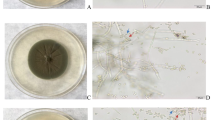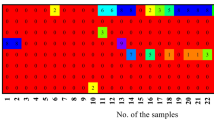Abstract
Ninety-two samples of olive leaves showing cercospora leaf spot (CLS) symptoms were collected from 1995 to 2003 in Spain and Morocco. Additionally, leaves were also collected from four carob groves showing CLS symptoms. Five representative isolates of Pseudocercospora cladosporioides, the causal agent of CLS, were recovered from the affected olive leaves and used to evaluate the effect of different culture media on mycelial growth and conidial production. Conidia obtained from the leaf samples were used for morphological and pathogenic characterization. Slow mycelial growth was observed on most of the culture media tested, with Czapek Dox agar, malt agar and diluted PDA being the most successful. Colonies of P. cladosporioides showed two well-differentiated mycelial types. Production of conidia was not observed in any culture media. The conidia obtained from the leaves were hyaline, septate, straight or slightly curved, rounded at the apex and with truncated basal cells with a rounded end. Large differences in length and width were observed between the conidia of P. cladosporioides and those of P. ceratoniae, obtained from olive and carob, respectively. The optimum growth and germination temperatures ranged from 15 to 25 °C. Pathogenicity tests on detached olive leaves and fruit demonstrated that the minimal incubation period was 30 and 7 days, respectively. The length of the latency period was 11 months in the pathogenicity tests on the olive plants. Disease symptoms only developed on youngest leaves. This study provides relevant information regarding in vitro management of P. cladosporioides and its pathogenicity to olive.





Similar content being viewed by others
References
Analytical Software. (2013). Statistix 10. User's manual. Tallahassee, FL.
Ávila, A., Groenewald, J., Trapero, A., & Crous, P. (2005). Characterisation and epitypification of Pseudocercospora cladosporioides, the causal organism of Cercospora leaf spot of olives. Mycological Research, 109, 881–888.
Barnett, H. L., & Hunter, B. B. (1998). Illustrated genera of imperfect fungi (4th ed.). USA: APS Press.
Barranco, D., Fernández-Escobar, R., & Rallo, L. (2017). El Cultivo de Olivo. Madrid: Edition Mundi-Prensa.
Braun, U. (1993). Taxonomic notes on some species of Cercospora complex (III). Mycotaxon, 48, 275–298.
Crous, P. W., Braun, U., Hunter, G. C., Wingfield, M. J., Verkley, G. J., Shin, H. D., Nakashima, C., & Groenewald, J. Z. (2013). Phylogenetic lineages in Pseudocercospora. Studies in Mycology, 75, 37–114.
Del Moral, J., & Medina, D. (1985). El "repilo plomizo" del olivo causado por Cercospora cladosporioides Sacc., enfermedad presente en España. Boletín Sanidad Vegetal Plagas, 11, 31–36.
Dhingra, O. D., & Sinclair, J. B. (1985). Basic plant pathology methods. Boca Raton: CRC Press.
Ekpo, E. J. A., & Eruruoso, O. F. (1978). Growth and sporulation of Cercospora cruenta and Cercospora canescens in culture. Canadian Journal of Botany, 56, 229–233.
Fajola, A. O. (1978). Cultural studies in Cercospora taxonomy: 1. Interrelationships between some species from Nigeria. Nova Hedwigia, 29, 912–921.
Farr, D. F., & Rossman, A. Y. (2018). Fungal Databases, U.S. National Fungus Collections, ARS, USDA. https://nt.ars-grin.gov/fungaldatabases/. Accessed 6 June 2018.
Favaloro, M. (1970). Infezioni di Cercospora cladosporioides Sacc. su frutti di olivo. Informatore Fitopatologico, 20, 7–9.
García-Figueres, F. (1991). Repilos del olivo: ataque en fruto. Phytoma España, 25, 31–36.
Groenewald, J. Z., Nakashima, C., Nishikawa, J., Shin, H. D., Park, J. H., Jama, A. N., Groenewald, M., Braun, U., & Crous, P. W. (2013). Species concepts in Cercospora: Spotting the weeds among the roses. Studies in Mycology, 75, 115–170.
Hansen, H. N., & Rawlins, T. E. (1944). Cercospora fruit and leaf spot of olive. Phytopathology, 34, 257–259.
Harelimana, G., Lapoivre, P., Jijakli, H., & Mourichon, X. (1997). Use of Mycosphaerella fijensis toxins for the selection of banana cultivars resistant to black leaf streak. Euphytica, 96, 125–128.
Hau, B., & Kranz, J. (1990). Mathematics and statistics for analyses in epidemiology. In J. Kranz (Ed.), Epidemics of plant diseases (pp. 12–52). Berlin: Springer International Publishing AG.
Henricot, B., Gorton, C., Denton, J., & Denton, G. (2009). Pseudocercospora cladosporioides, the cause of leaf spot on olive, a pathogen new to the United Kingdom. Plant Pathology, 58, 803.
Hoagland, D. R., & Arnon, D. I. (1950). The water culture method for growing plants without soil. California Agricultural Experiment Station, Circular, 347. College of Agriculture, University of California. Berkeley: California.
Karaoglanidis, G., Ioannidis, P., & Thanassaulopoulos, C. (2000). Reduced sensitivity of Cercospora beticola isolates to sterl-demethylation-inhibiting fungicides. Plant Pathology, 49, 567–572.
MAGRAMA. (2016). http://www.magrama.gob.es/es/agricultura/temas/producciones-agricolas/aceite-oliva-y-aceituna-mesa/aceituna.aspx#para2. Accessed 6 June 2018.
Maia, A. J., Shwan-Estrada, K. R. F., Faria, C. M. D. R., & Santos, L. A. (2015). Spore production and effect of temperature and light on germination and infection by Pseudocercospora vitis in grape plants. Summa Phytopathology, 41, 287–291.
McKenzie, E. H. C. (1990). New plant disease records in New Zealand: Miscellaneous fungal pathogens II. New Zealand Journal of Crop and Horticultural Science, 18, 65–73.
Nigro, F., Ippolito, A., Gallone, P., Carmingnano, P., & Romanazzi, G. (2002). Cercosporiosis of olive in Apulia and attemps to control the disease. Acta Horticulturae, 586, 773–776.
Obanor, F. O., Walter, M., Jones, E. E., & Jaspers, M. V. (2008). Effect of temperature, relative humidity, leaf wetness and leaf age on Spilocaea oleagina conidium germination on olive leaves. European Journal of Plant Pathology, 120, 211–222.
Oliveira, T., Moral, J., Bouhmidi, K., & Trapero, A. (2005). Morphological and cultural characterization of isolates of Colletotrichum spp. causing olive anthracnose. Boletin Sanidad Vegetal Plagas, 31, 531–548.
Pappas, A. C. (1975). Cercospora cladosporioides on olive fruits and leaves in Greece. Phytopathologia Mediterranea, 14, 44–45.
Pappas, A. C. (1993). Mycocentrospora cladosporioides on olive in Greece. EPPO Journal, 3, 405–409.
Perrotta, G., Cacciola, S. O., Pane, A., & Faedda, R. (1998). Outbreak of a leaf disease caused by Pseudocercospora ceratoniae on carob in Sicily. Plant Disease, 82, 1401.
Pettinari, C. M. (1952). Diffusione, biologia e terapia di Cercospora cladosporioides Sacc. parassita dell'olivo in Italia. Bolletino della Stazione di Patologia Vegetale di Roma, 10, 233–244.
Saccardo, P. A. (1886). Sylloge Hyphomycetum. Sylloge Fungorum, 4.
Sparapano, L., & Graniti, A. (1978). Cutin degradation by two scab fungi: Spilocaea oleaginae Hugh, and Ventura inaequalis, (Cke) Wint. In Z. Kiral (Ed.), Current topics in plant pathology (pp. 117–131). Budapest: Akadémiai Kidaó.
Steel, R. G. D., & Torrie, J. H. (1985). Bioestadística (2nd ed.). Bogotá: McGraw-Hill.
Trapero, A., López-Escudero, F. J., & Blanco, M. A. (2017). Enfermedades. In D. Barranco, R. Fernández-Escobar, & L. Rallo (Eds.), El cultivo del olivo (pp. 735–793). Madrid: Edition Mundi-Prensa.
Triki, M. A., & Rhouma, A. (2008). First report of Pseudocercospora cladosporioides, the causal agent of Cercospora leaf spot of olive trees, in Tunisia. Phytopathologia Mediterranea, 47, 262–265.
Viruega, J. R., Roca, L. F., Moral, J., & Trapero, A. (2011). Factors affecting infection and disease development on olive leaves inoculated with Fusicladium oleagineum. Plant Disease, 95, 1139–1146.
Acknowledgments
This research was supported by projects AGL2000-1725 and AGL2004-7495 from the Spanish Ministry of Science and Technology and by the project “Validación del modelo epidémico Repilos” funded by the Bayer CropScience. C.A.B. is the holder of a ‘Juan de la Cierva-Incorporación’ fellowship from MINECO. The authors thank F. Luque for her skilful technical assistance.
Author information
Authors and Affiliations
Corresponding author
Ethics declarations
Authors declared that this manuscript have not published elsewhere. All the authors have read very carefully and approved current version of this manuscript. All authors also declared that the data or images have not manipulated.
Disclosure of potential conflicts of interest
The authors declare that they have no conflict of interest.
Research involving human participants and/or animals
This research is focused on identification of some fungi causing diseases on plants. This article does not contain any experiments with human participants or animals.
Informed consent
Please be informed that authors are satisfied to publish this work in European Journal of Plant Pathology.
Rights and permissions
About this article
Cite this article
Ávila, A., Romero, J., Agustí-Brisach, C. et al. Phenotypic and pathogenic characterization of Pseudocercospora cladosporioides, causal agent of cercospora leaf spot of olives. Eur J Plant Pathol 156, 45–65 (2020). https://doi.org/10.1007/s10658-019-01861-5
Accepted:
Published:
Issue Date:
DOI: https://doi.org/10.1007/s10658-019-01861-5




